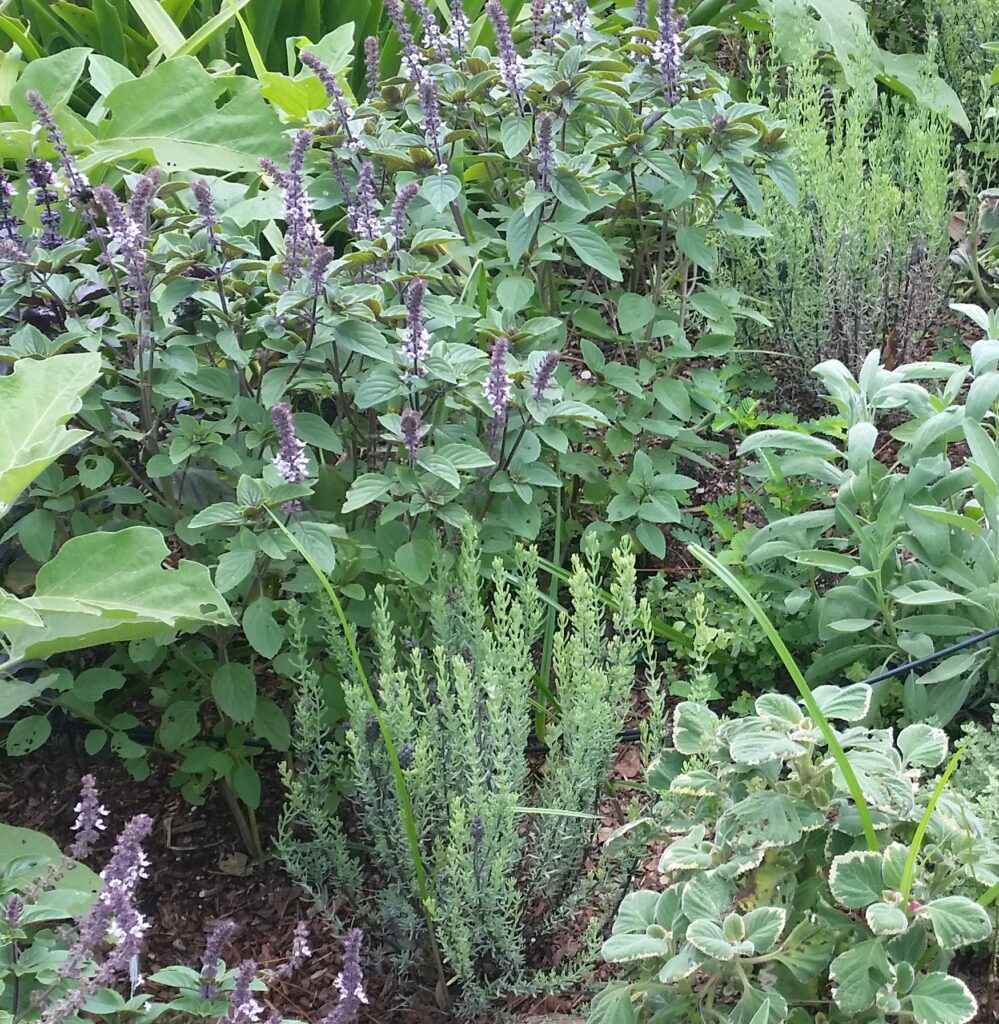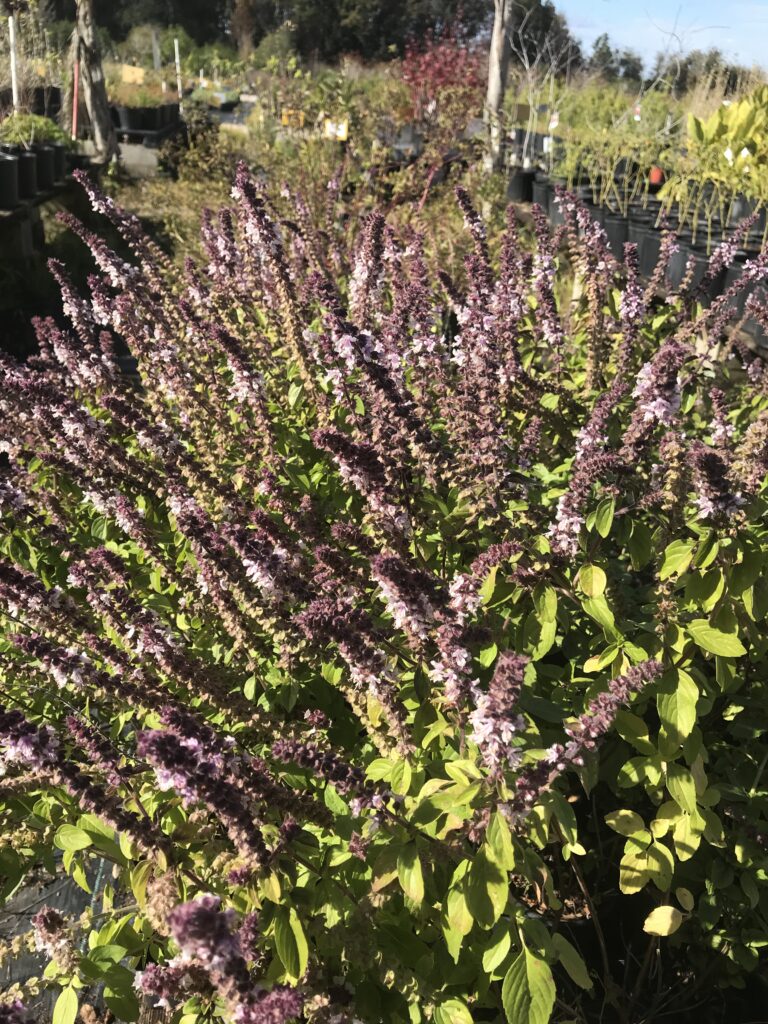Growing African Blue Basil Herb Plants in Northeast Florida Herb Gardens
(Ocimum basilicum ‘African Blue’)
African Blue Basil Herb Plants For Northeast Florida Origins:

Basil plants originate in tropical areas of Asia, Australia, and Africa. There are currently 35 species of basil with lots of cultivars being developed within those species. All basil is prized for its highly aromatic foliage and most have a spicy scent and taste.
African Blue Basil is my absolute favorite when it comes to incorporating your herbs into your perennial flower beds. It takes the summer heat even when planted in full on all day sun and keeps on producing wonderfully edible foliage even as it blooms! So there’s no need to fuss over dead heading those pretty blooms to keep your basil plants producing foliage. What you end up with is a beautifully blooming plant that will rival any garden salvia for curb appeal and plenty of basil leaves for the kitchen!
The photo of Africa Blue Basil was taken in July or August the summer of 2014. I planted herbs and even a few vegetables into the front 2 ft of the nursery landscape where I normally put flowers. Everybody thought I was crazy but the result was beautiful, mostly thanks to those African Blue basil herb plants!
Growing Season for Northeast Florida African Blue Basil Herb Plants:
There’s no denying I do love these plants, the blooms, the smell, Italian dishes you can use them in… it all adds up to a pretty perfect package in my book! But even with all those wonderful attributes, by far my favorite quality of African Blue Basil when planted into the Northeast Florida, Jacksonville and St. Augustine is that it is a tender perennial plant, not an annual like most basil herb plants in our climate! Basil fresh from the garden right in the middle of December, what more could you ask for?
Your plants could last a season or two depending on your planting location and the winter temperatures, I like to take a few cuttings in November and stick them into a moist pot to root so I am sure to have some to plant out the next season, just in case!
Sun Exposure for African Blue Basil Herb Plants in Northeast Florida:
Most basil herb plants need afternoon shade to make it through our summer heat and rains here in Northeast Florida. So you can imagine I was a little skeptical to try it at first, but I’m glad I gave it a try, I have had great success with African Blue basil plants in full on all day sun. I thought for sure they would croak in August but here it is September and they are still beautiful!

Soil Preference for African Blue Basil Herb Plants:
Moist, but well draining soils. Root rot can be problematic in continuously water logged soils.
When planting Basil into the ground, amend the soil generously with compost. It acts as a sponge and helps to keep the soil moist and well drained. Basil planted into the ground during the summer months will suffer root rot during the rainy season if the soil is not well drained. (Planting under root thirsty trees will alleviate this problem, but you will have to remember to water well when it’s not raining, just as you would with potted herbs).
Amend your planting site generously with compost when installing your new Basil plants.
Basil also makes a great container plant as well, as the plant and root system take up very little room. For best results, allow the larger selections of basil an 8-12 inch wide space in your container to grow. You may, however, want to consider adding a soil moisture retention granule like soil moist to your potting soil mix to help conserve water.
Water and Fertilizer Requirements of African Blue Basil Herb Plants:
Water daily after planting for the first week and then over the next few weeks taper back watering to suit your soil and sun exposure as needed.
In General, Herbs need very little fertilizer. To much fertilizer can lead to lush green growth with low volatile oils in the plant, less oils equals less flavor and aroma for your herbs. However, when planting into Florida’s sandy soils you may find your plants in need of a boost. If so, try fertilizing with a mixture of organic fish emulsions and seaweed at one ounce of each per gallon of water. Put into a sprayer and water every other week or as needed with the mixed solution. If your leaves still look a bit lackluster consider a bit of blood meal fertilizer.
Or, if you find your plant struggling at any point, make up a batch of compost tea and water generously. Repeat as needed weekly or biweekly.
Size of African Blue Basil Herb Plants:

The mature size on a African Blue basil plants will be from 18-24 inches tall with a 12-24 inch spread. Although, I have seen older plants that overwintered reach to around 3 ft high and just as wide. African Blue basil herb plants tend to be a bit taller when planted into a shadier location.
Sowing African Blue Basil Herb Seeds into Northeast Florida Soils:
African Blue basil plants are sterile, plants will need to be propagated from cuttings placed in moist soil for a few a week or two.
Harvesting African Blue Basil Herb Plants in the Northeast Florida Landscape:
Basil needs to be pinched frequently in order to make them branch out and fill in. Harvesting should be done throughout the growing season. The strong fragrance of the African Blue basil will perfume a kitchen when cut and brought in from the garden to display!
Harvesting your African Blue basil isn’t required like it is with other basil herb plants, but those lovely lavender flowers sure are pretty in a vase by your kitchen sink!
Blooms of African Blue Basil Herbs for Northeast Florida Landscape:
Such a lovely lavender bloom spike on top of the dense purple tinged foliage no other herb has ever known. Truly I do think that African blue basil blooms belong in the flower garden, it attracts bees, butterflies and birds!!!

